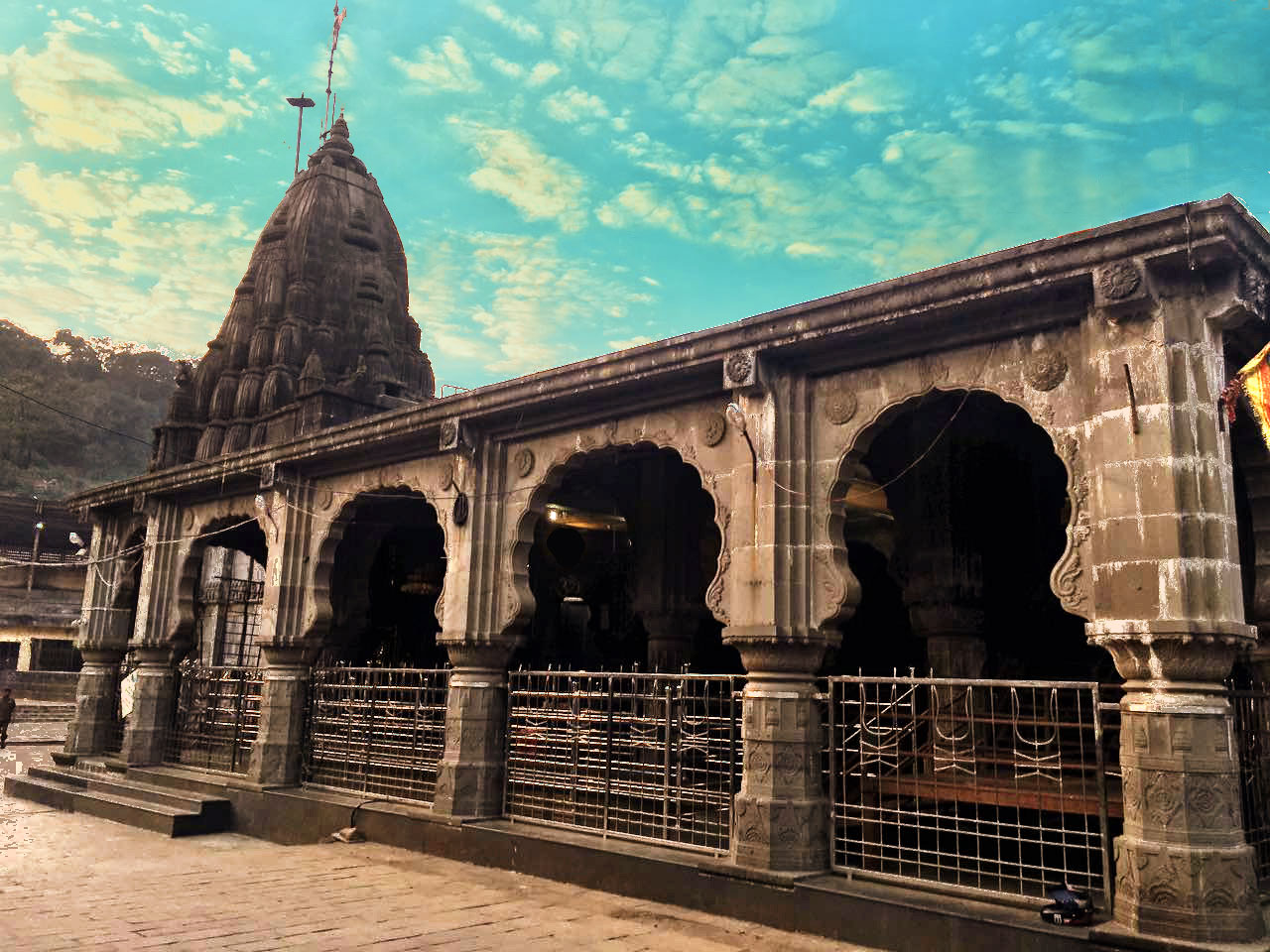
After a night halt at Aurangabad, we were ready to imbibe the serenity of the one who is omnipresent. The one, whose name resonates divinity, translates Moksha and accommodates safety. Our next destination was Bhimashankara, the sixth of the 12 holy Jyotirlingas of Shiva. Shiva’s sixth divine abode – Shri Bhimashankara
Shiva’s sixth divine abode – Shri Bhimashankara
If you are a keen devotee of Shiva, like all of us, then you must take a trip to Shri Bhimashankara, situated amidst the beautiful landscapes of Central Maharashtra. Right there, at the focal point, one can sense the divine aura of Shiva, the almighty of all. You will echo the sentiment that there is none as boundless as him, none as swift as him, none as intrepid as him and none as benevolent as him. Shiva stands at the utmost.
Off to the divine destination
Bhimashankara is about 273 kms from Aurangabad and it takes nearly 4 hrs drive to reach the holy place. After all time and distance calculations we boarded our Audi at 7 in the morning. After a journey of about 2 and a half hours on Aurangabad-Ahmed Nagar road, you will enter a small village called Parner, situated only 10 minutes away from Anna Hazare’s village – Ralegaaon Siddhi. We specifically mention the place because it utterly lacks Midway culture. Or let us be more specific – Government ignores the comfort of women travelers on this route at least. Being a state highway, the unavailability of basic amenities is rather disappointing. Yes, you will find some dilapidated restaurants along side the highway but the unwelcoming sights of loud ‘BAR AVAILABLE’ signage decorating the walls of these restaurants make the women travelers even more uncomfortable to stopover and use amenities.
Although, a silver lining in the dark cloud was Family Garden restaurant at Parner, with no alcohol clause displayed prominently at the entrance made us settle with the same. We met the very courteous manager of that small restaurant, Bhau Saheb Dhodiba Khilari, who reassured the no alcohol clause. Enjoying the simple local dialect, we brunched some delicacies and geared our journey. It was indeed a wonderful sight to notice shimmering stones under the sunlight in the whole area. Actually the area is rich with zeolites, which are actually basaltic rocks, settled after volcanic explosions. After crystallization, these rocks have quality to store such elements, which help in the purification of air and water. The polluted states should definitely look forward to this brilliant arrangement of nature and take advantage of this natural resource.
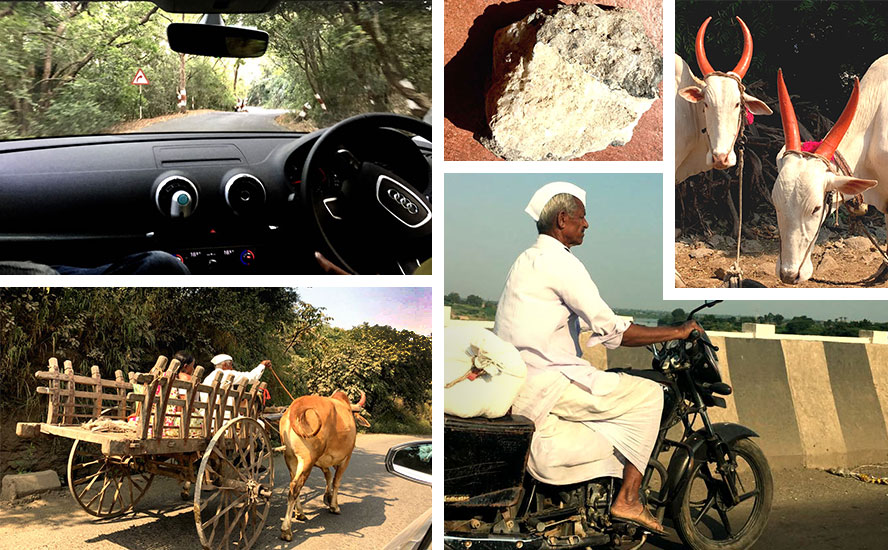
The double lane coal tar road, newly constructed smells fresh – infusing excitement. The area also translates the rustic life perfectly. Abundant on Tomatoes and onion productivity, the air in this part bears the piquant smell of the same. Bullock carts pulled by Khillari breed of oxen adorn men in typical Mancheri Marathi topi and women in Navari Saree, representing the colors and spirit of rural Maharashtra. “Tumhala Marathi Yete, Samjhat Nahi Punah Sanga, Aapan Marathi Bolat Kaay” their local dialect, although a bit understandable was more evident from their innocent faces which clearly translated their questions. Their queries posed the inquisitions.
We reached Bhowargiri via Parner and Manchar. The Sahyadri range all around was enchanting. Everything around was a bliss – firm mountain range and the folk culture blending was a perfection. Great Hindi poet, Padmakar ji’s lines – यहीं स्वर्ग/सुरलोक/ यहीं सुर कानन सुन्दर/ यहीं अमरन को ओक/ यहीं कहुं बसत पुरंदर…which translated the beauty of the place – perhaps it was all here. Everything – the heaven, nectar, eternity…everything. And this beautiful way would lead us to Bhimashankara reserved forest range.
The beautiful Maharashtrian village culture
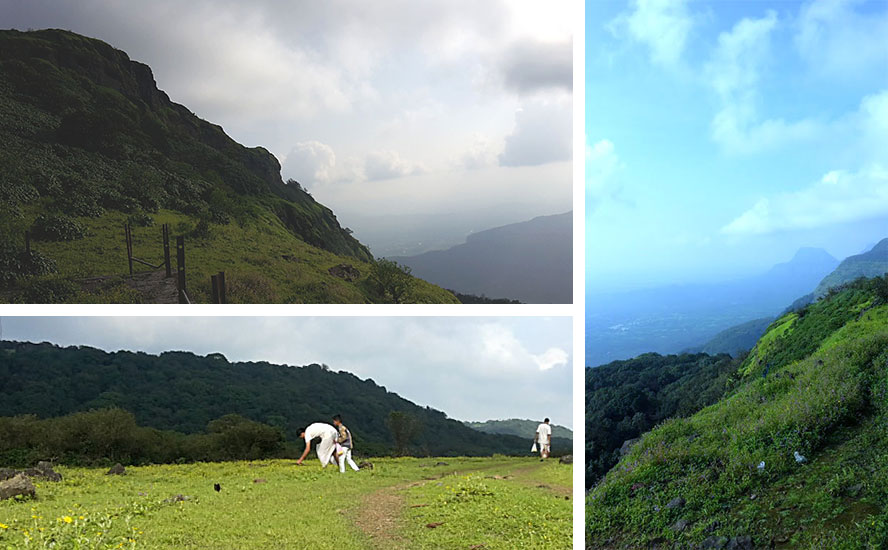
Locales were busy taking care of the Paddy fields and in the periphery were Sal, Sagoun, Bamboo, Mango, Jamun and karwi trees. There was the famous Neel Tree which is known for flowers blossoming once every seven years. We tried to decode our individual prospects with the nature. Never will you romance at neck of the woods, at such a level amongst chirping birds and swaying trees. We were trying to decipher the coexistence of ‘us’ and the ‘almighty’ – his might and our worth both existing in this harmony surrounded by the nature, gliding in our thoughts we didn’t realize that we reached 3500 ft above the sea level already. Soon we arrived Shri Bhimashankara kshetra, on the boundary of Aambe village and Rajgurunagar. A flight of staircase going down would lead us to the divine temple. We took 150 steps to reach down each one of them creating a holy aura with shops adorning deities and other ingredients for pujan and offerings.
The Heavenly Abode – Shri Bhimashankar
We were standing at Shiva’s abode – Shri Bhimashankara. Shiva – free from all worldly vices, who is complete yet seeks fulfillment from his Ardh nari. The ultimate. The Almighty. Further five stairs leading us to the Garbha griha where Shiva endured the place in all his grace in the form of east facing Jyotirlinga. We were overwhelmed being a part of this holy sight. The never ending echoes of the chants, the extreme passionate desire towards Shiva and the fact that he is around in the smallest bit – what else does a Shiva devotee need. His better half, the one who completes him – Devi Parvati abide by his side.
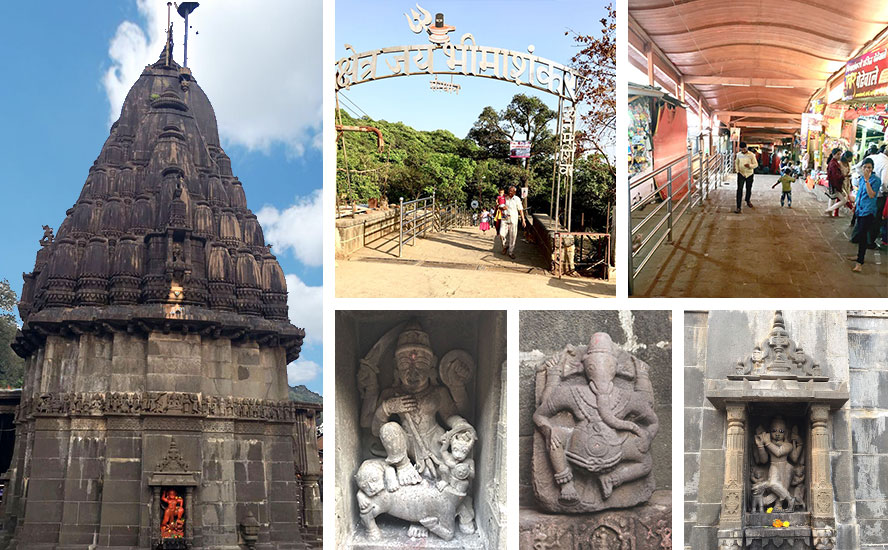
In the Sabha Mandapa are the idols of Kurma and Nandi – the Bull, who teach you to be progressive, patient and wise. Shri Ganesha and kaal Bhairav guard the entrance. If you excel their tests then only you qualify to be a true Shiva Bhakta.
Inception of Bhiamshanka – folklores and legends
We met the priest of the temple, Shri Ratnakar Raghunath Kodilkar, who belongs to the 13th generation of his family serving the temple and performing the holy rituals. He told us the Rigveda specifies worshipping Lord Rudra and devi Dakini on the Dakini hills. The mythological legends mention killing of the devil Tripurasur in the Dakini Devi forest range.
Ancient scriptures mention that Tripurasur was an evil king indulged in worldly pleasures and Devas were fed up with his proscribed practices. They hailed help from Lord Shiva who in turn suggested to Lord Brahma and Indra to offer prayers to the Adishakti enduring the Bhimashankara hills with lotus flower. The Kamalja Devi (Goddess from the Lotus) near the Bhimashankar temple, is associated with this legend.
With the help of Adishakti, Shiva himself killed Tripurasur with Vishnu’s arrow and Vasuki’s bow. Local legends say that after this clash, Shiva took refuge at Bhimashankar hills to relax and his sweating body formed streams of water, which in turn formed a river called Bhima. This victory of Shiva over Tripurasur is celebrated with zeal on Kartik Purnima, observed as Tripuri Purnima. The locales and tribes from the nearby area gather and offer Kheer to the Lord and ask for his consecrations. Temple is lit with oil lamps and Shiva Linga is decorated in accordance of the festivities.
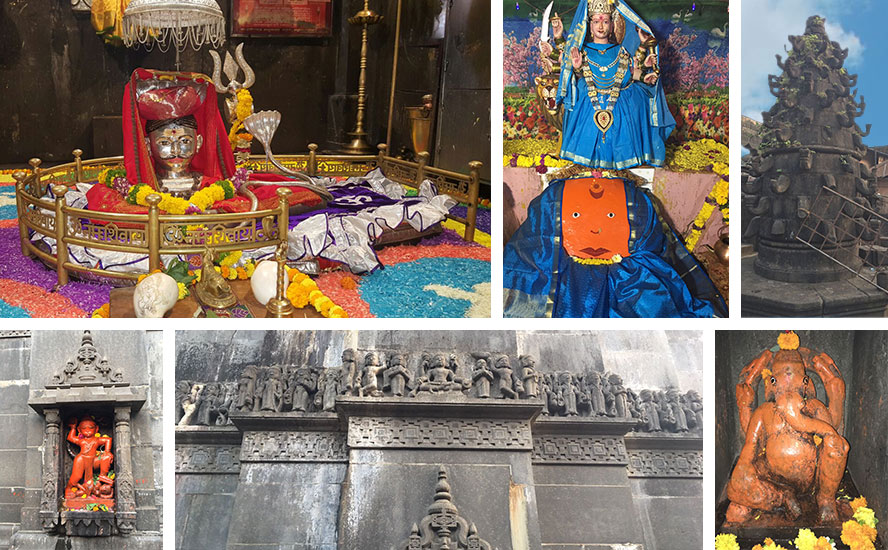
Another legend as to how the temple emanated is rather interesting. A devil named Bhima was born from Kumbhakarna and Karkati. He enslaved the Devas. He overpowered Shivas’s greatest devotee Kaamrupeshwar and put him in the dungeon. Narad Muni followed by a war with Shiva’s bow-arrow and Trishul, turned him into ashes with his blow, as mentioned in the folktales. The Devas then pleaded Shiva to reside in the place and he obliged. Thus Bhimashankar, came into existence.
Another interesting legend states that this hill was once called Rathanchal due to the chariot shape. There was a woodcutter called Bhati Rao. With every stroke of his axe, trees would bleed and earth started turning red, soaking the blood. A cow standing nearby couldn’t take this and started spilling milk to soak that blood and the bleeding trees eventually were cured. Later, a temple was built on the place and it was believed that Shiva chose the place to adorn. Old rock-stones have 1200 BC engraved as the year of this temple made by Vinayaka Rao.
Local texts specify the renovations of the temple several times. There are also texts mentioning AhilyaBai Holkar’s efforts to build a Dharmashala for the pilgrims. In 17th century Radhobabadada Peshwa built Deepmalikas for offerings and Havans. Another moneylender from Pune Chimanji Antaji Bhide built Sabhamandap in 1437 and initiated beautiful carvings on shell structures. With the help of Dixit and Patvardhan clans in the Peshwa age, Nana Fadanvis got much financial support to build a Shikhar in the temple which at that time amounted to 50 thousand rupees.
The temple has black walls with Dashavtara tales engraved all over depicting the patience and ingenuity of the artists. The interlocking of various areas of the temple unmistakably represents the Hemarpanthi style of architecture though; the temple also reflects influence of Jain and Sindhu Arya style according to some researchers.
Shani Mandir and the Giant Bell
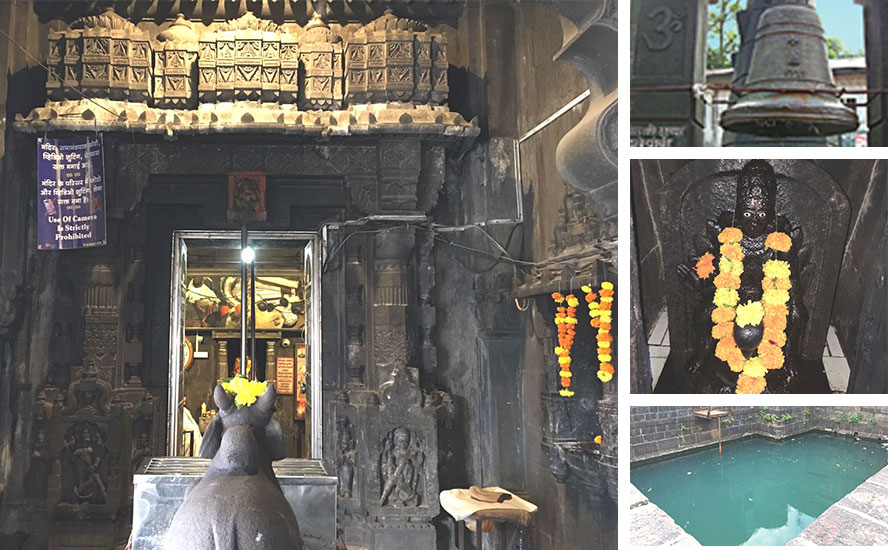
Right out side the Shiva temple one notices a huge bell at the Shani temple situated in the main premises that catches the attention of devotees. The bell is portuguese and was brought in the Maratha era from the chapel of Basai (Bombay Gazetteer Page no. 120 mentions the same). The big bell resonates high and can be heard at great distances. But since it is now old and has started rusting, it’s gong is being removed and as a part of formal ritual it is resonated with a small stone in the morning before the temple doors open.
Pandit Ratnakar told us that the great Marath King, Chhatrapati Shivaji initiated prayers in this temple and was keen to assure that it is provided special care. He gifted Kharoshi village from Rajgurunagar to this temple and till date, the temple receives 450 rupees from this village every year for maintenance.
The pujan arrangements in the temple are quite organized. For special prayers, one has to offer 1000 rupees for Jal Abhishek, 5100 rupees for Laghu Rudra Abhishek, 3100 rupees for Maha Pooja and 2100 rupees for Rudra Abhishek. Apart from this, 18 purohits take appropriate care of daily offerings and Prasad distribution. There is a special facility to post Prasad to the devotees to their respective addresses. Around 100 envelopes are dispatched from the post office mentioning the name, Address and Gotra of the devotee. The Purohits are dedicated towards their work and every inch of the place resonates purity and sincerity in the name of Shiva.
The temple premise has a small pond or pool, to be precise, and the water is supposed to be coming from the Holy river Bhima. It is believed that Kaushik saint, with his mighty power, made this pool which is supposed to enlighten or bequest Moksha. The tombstones depict that Bhima River is also called Bhimarathi. The latter finds its mention in Chalukya dynasty, ruled by Kings Pulakeshi II around 614BC. The river finds its origin on the hills in the form of a stream and turns into river, flows 725 km in South-East and reaches Karnataka to combine with River Krishna.
Bhimashankar stands calmly between Dakini and Shakini hill ranges, both supposed to be wives of Tripurasur. Any Pilgrimage turns into a heavenly abode if you find peace and solace. If you wish to experience such serenity, one should definitely pack bags to Bhimashankara.
Shri Laksha Vinayak Ganesh Peeth
Now, it was time for way back home. But since we had some time in hand, we thought of visiting one of the 21 divyadhams of lord Ganesha, Shri Laksha Vinayaka. We reached Verul, travelling 278 kms on MHSH112/54. The one who is offered the first prayers amongst the Gods is Lord Ganesha and out of 21 Ganesha abundant regions, Maharashtra has the most. We couldn’t plan any such trip earlier so this time, we made a point to visit Verul. It has 17th, Ganesha Peetha situated very close, precisely at a walking distance, to Shri Grishneshwar Jyotirlinga.
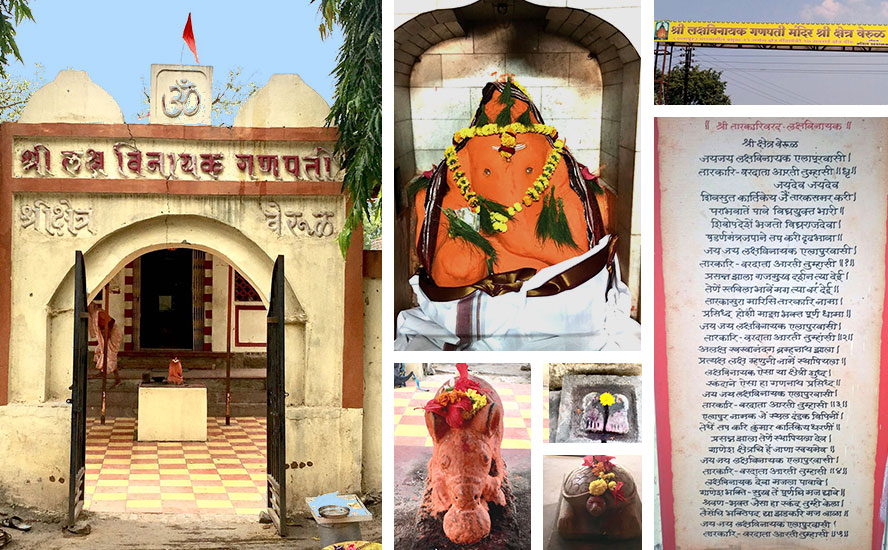
Legend to the emancipation of this holy place was told by Shashikant Pujari ji, the temple priest. According to Skanda Purana, in the Treta Yuga, Kartik was victorious in killing Tarkasur just because he ensconced and prayed Ganesha on Lord Shiva’s behest. He established a betel nut (Supari) as a mark of the Lord Ganesha and offered prayers with 1 lakh Atharvashirsha chants, 1 Lakh Durva arpan and 1 Lakh pradakshina. Lord Ganesha himself incarnated from the betel nut. Maharani Ahilyabai Holkar later built a temple at the place. The temple reflects simplicity and piety. A tortoise and Mushak (the Mouse) idols also adorn the place. Ganesha, who is the Lord for art and knowledge is Ananta (one who is seamless) and after seeking blessings we left for Aurangabad.
Our refuge – Hotel Rama International
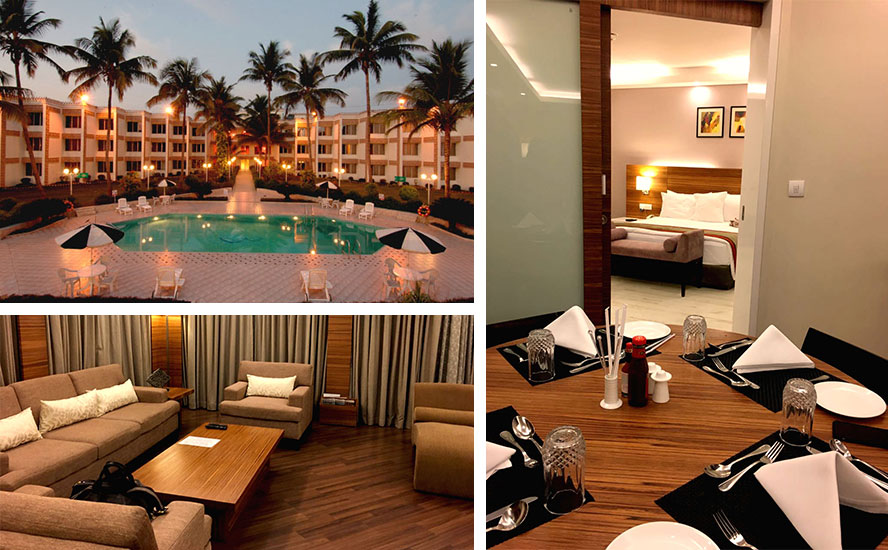
45 minutes drive on NH 52, crossing the Daulatabad fort, we took refuge to Rama International Hotel. The hotel is a part of the prestigious Welcome Group and is a luxury, 132-room hotel, with world-class facilities. The contemporary décor is appealing. The staff was very cooperative and cordial that makes the hotel lead the group and bring it to the forth. We now wind up this journey. Stay tuned for the next.

It’s nice to read an article like this, that shows the writer thinks outside the box! You definitely made me think! Thank You-I hadn’t considered things from that angle otherwise. Gonna share this…
This is most helpful piece I have seen, when most people writing about this won’t stray from the standard opinion. You have a great writing style, and I shall follow you as I enjoy your posts.
My family members every time say that I am wasting my time here at web, except
I know I am getting knowledge daily by reading thes good articles
or reviews.